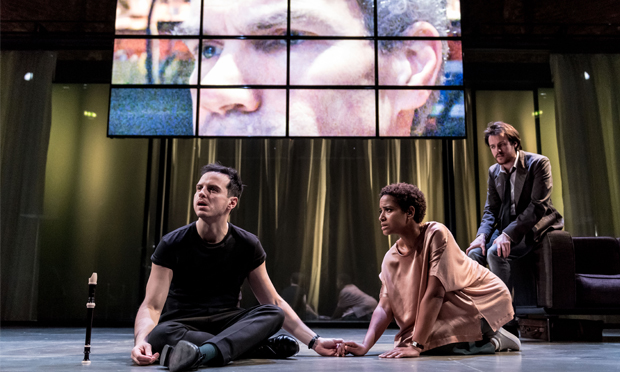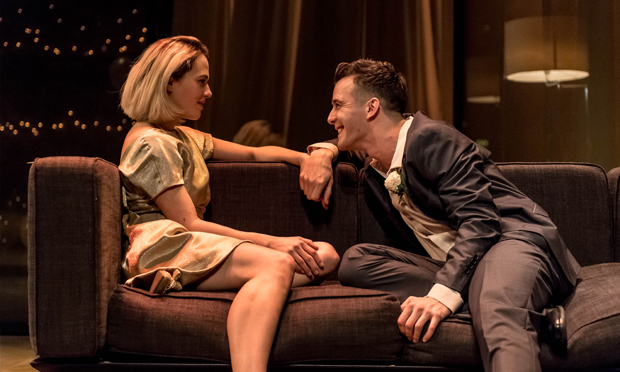Hamlet, Almeida Theatre, review: method and madness

Andrew Scott (Hamlet), Amaka Okafor (Guildenstern) and Calum Finlay (Rosencrantz). Photograph: Manuel Harlan.
Almedia’s Hamlet is not a conventional production. The text has been mashed up. The set’s pop-design, the use of videos, and odd pacing can be jarring; but it is also a stimulating experience and thought provoking too. Not everyone will like it, but they should be impressed by this reset of a classic.
Andrew Scott is a great choice as Hamlet, bringing massive emotional range to a role that has wild swings in mood as the character breaks down. He has a quiet presence and uses language delicately when needed, pausing before important words and phrases. Sometimes he is so hesitant as to be almost whispering and hard to hear; but he makes up for that when his voice almost jumps up a couple of octaves to screaming pitch, such is his intensity. This is Hamlet living on the edge of his emotions.
Angus Wright as Claudius is also excellent; suave and debonair, but with dark undercurrents. He got better and better as the play went on. Gertrude (Juliet Stevenson) is also good, though a touch wooden. Was that intentional? Ophelia (Jessica Brown Findlay) is a little too English-middle classy for this brutal play, though perhaps that highlights her vulnerability.
The production spares Hamlet no excuses for his terrible misogyny and the production lays this bare: we see Ophelia bruised as in domestic abuse. And when Ophelia goes mad, she is wheeled out in a wheelchair looking deathly ill. That scene improved her overall performance, as there was a clear contrast between the bubbly Oxford undergraduate demeanour of the first part and her subsequent manner. Peter Wright as Polonius is also too English in his ponderous ramblings. The play would have been better had the actors had a more pan-European feel, which appears to be what the designers are trying for in the set.

Jessica Brown Findlay (Ophelia) and Luke Thompson (Laertes). Photograph: Manuel Harlan.
The set is spare, with low but sharp lighting. They are going for the Scandi-trendiness of the 1970s: grey and dark colours, sliding windows, and long billowing curtains. The dress code is not ostentatious, but it’s definitely cool. These features suit the low-key nature of the production. Much of the dialogue is slowly and quietly delivered, adding to the stripped-down feel. It is a welcome break from more high-octane productions that are the norm. The pauses give you time to think about the play, bringing out the melancholy in many of the roles. At the same time, the actors also find more humour in the lines than is normally the case with Hamlet.
Ok, now for some bad things. Whoever thought playing Bob Dylan songs was a good idea? Is that because he is a Nobel now, so can be put alongside our Will? And one song appears right in the middle of the play within a play. The play’s text has been messed around with lots of speeches broken up and more modern renditions of the lines. It worked at times, but often sounded disjointed. The use of cameras and screens was fun with the projected ghost (David Rintoul) who turns real. There is a camera and projector running when the protagonists are viewing the play. The final words of the play given by Fortinbras (Elliot Barnes-Worrell) were delivered on video as a newscast.
But these techniques are a bit dated now, being all the rage a few years ago, in opera productions particularly. But I guess it is still fun. And this sense of surprise and mischief is just what is so enjoyable about this production.
Hamlet is at the Almeida Theatre until 15 April.
www.almeida.co.uk
